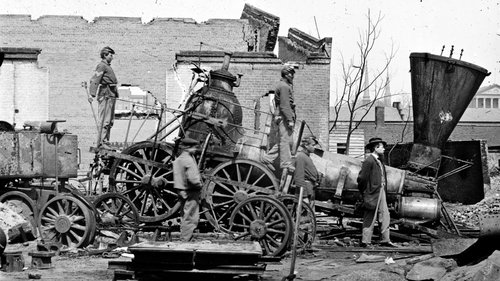Student Work
Economic Overview
by Josh Garner

Richmond, Va. Crippled locomotive, Richmond & Petersburg Railroad depot
http://www.loc.gov/pictures/resource/cwpb.02704/
Economic Overview during the Reconstruction Period in Mississippi
This piece of the Nielsen Ledger collection comes from the year 1871. This particular piece follows the transactions of one customer throughout the year 1871 whom was also a student at the University of Mississippi: Mr. Buford, which provides valuable insight as to the type of items that would be bought only once, compared to items that would be bought multiple times, such as cigars, pickles, nuts, oysters, and coffee. Being in North Mississippi, Oxford and Mississippi as a whole at this time were under Congressional Reconstruction or otherwise known as “Radical” Reconstruction policies. [i] Radical Reconstruction pushed for more government intervention in certain states to ensure that the African-American population would be given their civil liberties, and at this time Mississippi sent the first two African-American Senators to Congress. [ii] This period of integration allowed stores like Neilson’s to reach a broader customer base and allowed for business to increase. Keeping in mind how small of a town Oxford is, the economic development of the city took awhile to take hold as it was a pre-industrial society struggling to rebuild after the Union Army had just finished their scorched earth policy of warfare throughout the South. [iii] In an attempt to help promote economic growth, the Mississippi Constitutional Convention of 1868 approved a policy that would “delay payment of debt until economic conditions improved." [iv] This allowed towns throughout Mississippi to rebuild, and it allowed the people of Mississippi to get their finances back in order and rebuild their own lives after the Civil War. A major obstacle to this economic reconstruction was that there were not many legal institutions in place to help facilitate investments from outside the region, and share-cropping had become a major economic idea, which was revered as a plausible way to deal with the land, labor, and agricultural needs of Mississippi and many other southern states. [v] Sharecropping became detrimental to those whom entered the system though, as the people barely made enough to survive and became trapped in a cycle of poverty.
All of this information is necessary to set the scene for Oxford, Mississippi in 1871, and in particular set the scene for how a college student would have been using their money in this period of Radical Reconstruction. Mr. Buford would have been a member of a wealthier Mississippi family, as we know he was a student at the University of Mississippi. His transactions show a common theme in the type of items that would be purchased from Neilson’s. About once a month, Mr. Buford would charge his account at Neilson’s and would retrieve items such as cigars and oysters on a very regular basis. These two items appear to be very popular with the department store in general, but Mr. Buford seems to also be a fan of Neilson’s nuts and apples. From these transactions at this time period, we can tell that many of the items purchased were rather small personal items, than large purchases of clothes as somebody might expect for a department store. This is interesting as many people in this era probably did not have money at one time to make large purchases, but many could be found for daily items that improve a person’s quality of life.
Ledger 4, Page 72, 1871 from Neilson’s Collection, Department of Archives and Special Collections, The University of Mississippi Libraries.
Economic Overview
[i] “Reconstruction in Mississippi, 1865-1876.” Mississippi History Now online, accessed January 7, 2019,http://www.mshistorynow.mdah.ms.gov/articles/204/reconstruction-in-mississippi-1865-1876.
[ii] Hollis, Shirley A. “Neither Slave nor Free: The Ideology of Capitalism and the Failure of Radical Reform in the American South.” Critical Sociology 35, no. 1 (2009): 9-27.
[iii] Ruef, Martin and Kelly Patterson. “Organizations and Local Development: Economic and Demographic Growth among Southern Counties during Reconstruction.” Social Forces 87, no. 4 (2009): 1743-1776.
[iv] Snay, Mitchell. “Freedom and Progress: The Dilemma of Southern Republican Thought during Radical Reconstruction.” American Nineteenth Century History 5, no. 1 (2004): 100-114.
[v] alpern, Rick. “Solving the ‘Labour Problem’: Race, Work and the State in the Sugar Industries of Louisiana and Natal, 1870-1910.” Journal of Southern African Studies 30, no. 1 (2004): 19-40.
